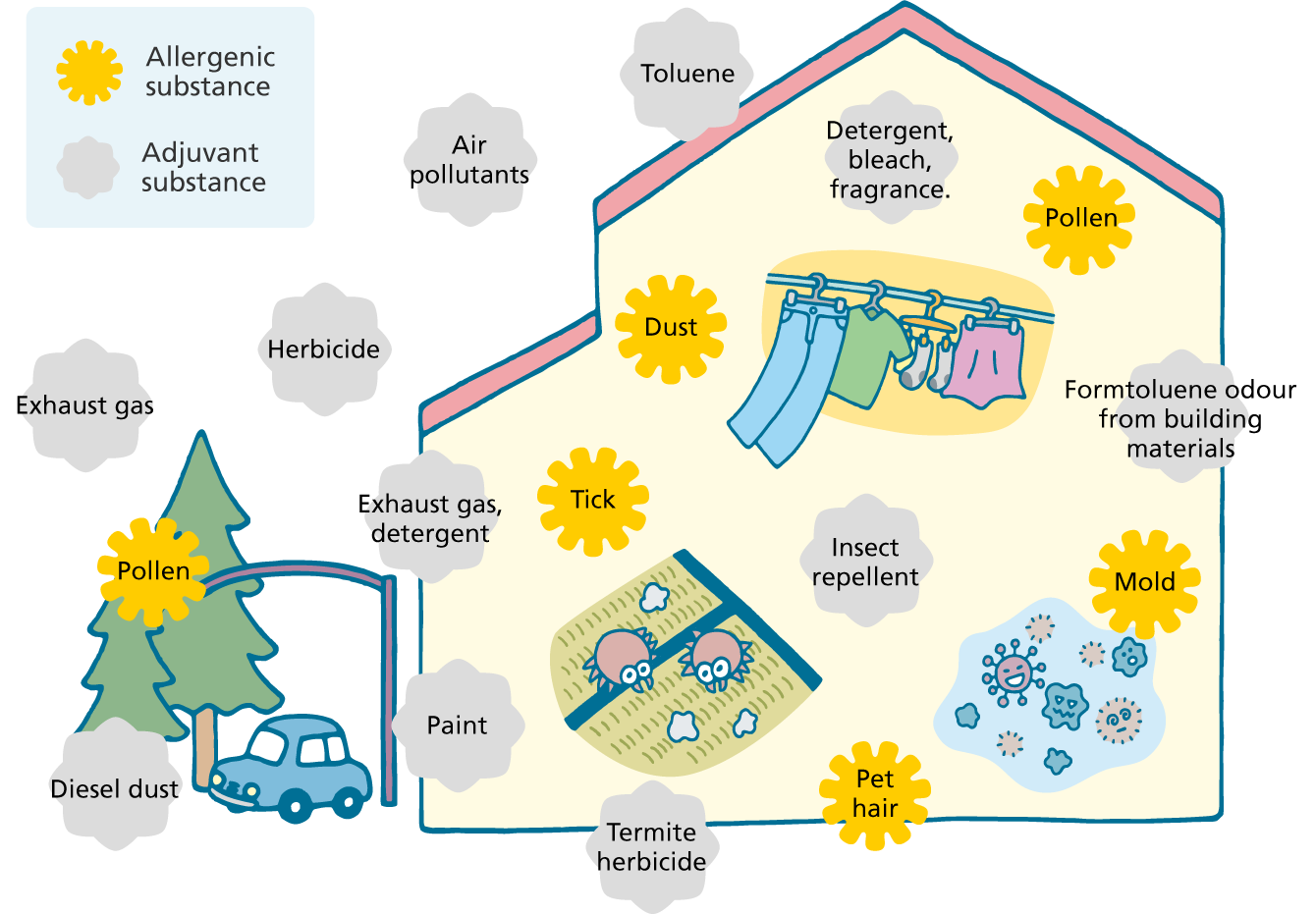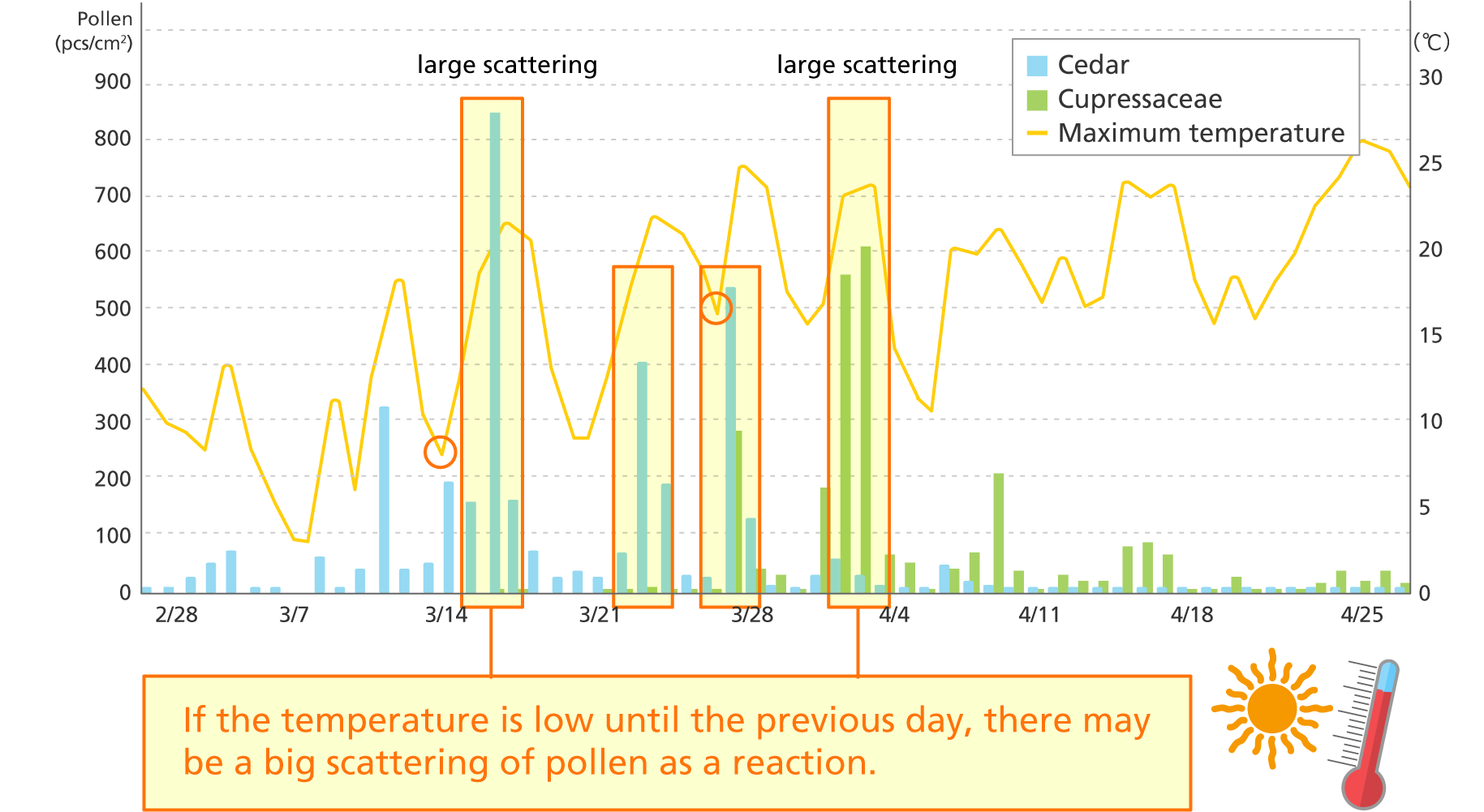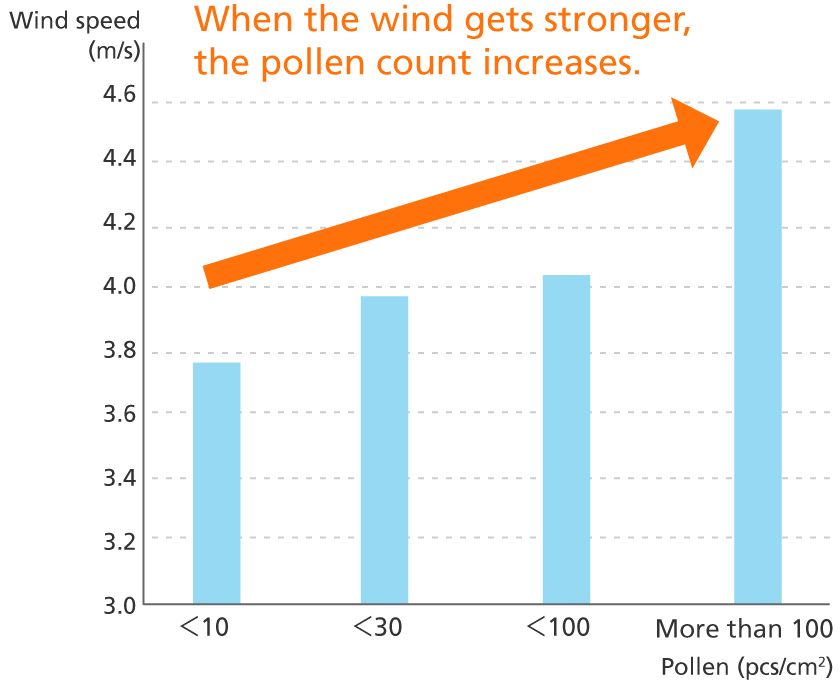
Problem
Problem
Pollen effect
The number of hay fever sufferers is increasing each year, and many people suffer from symptoms such as coughing and sneezing and itchy eyes during the pollen season.
In addition, since the powder adheres to the laundry, it also affects daily life as it is impossible to dry the laundry outside.
So here are some of the things that bother us about pollen and how to get through the pollen season.
Solution
Prevent pollen from entering the room
Indoor pollen and route of entry
Pollen sticks not only to ventilation but also to clothes and enters the room.
Also, smaller pollen grains tend to enter the room more easily than larger ones.
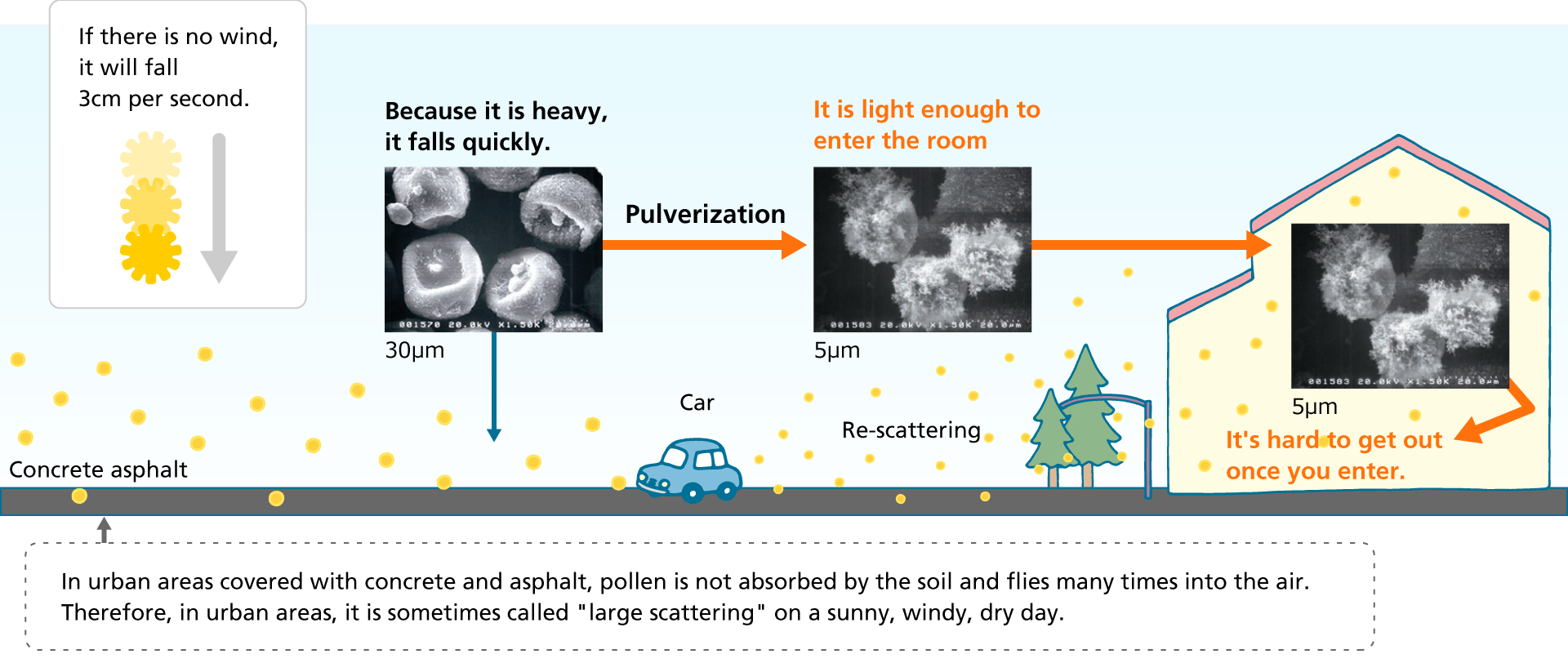
Main route of entry into the room
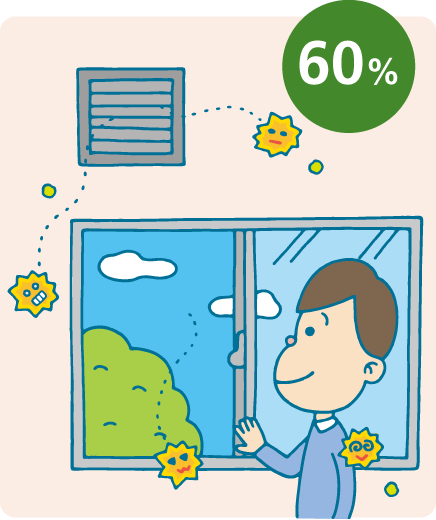
Windows and ventilation
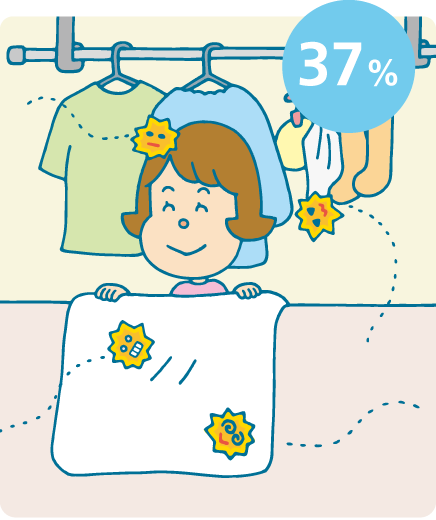
Laundry and futon drying
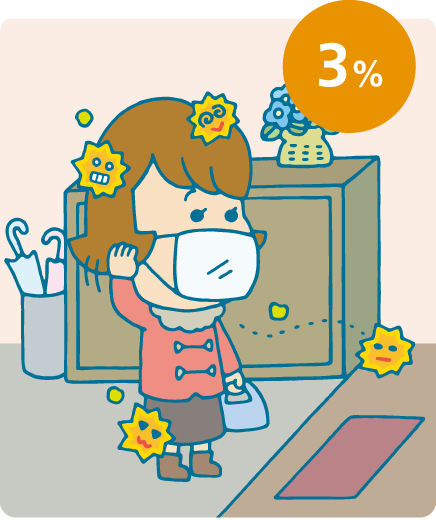
Clothes and hair when returning home
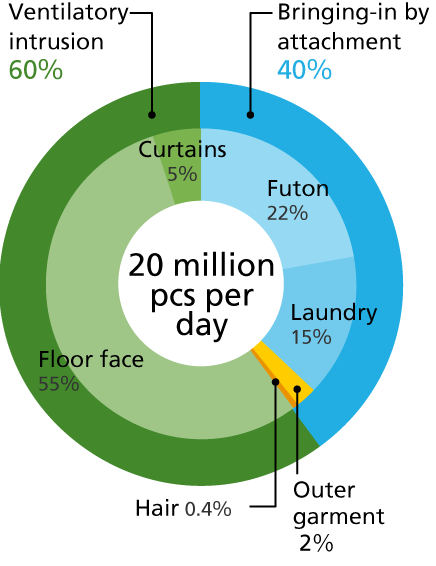
Pie Chart Source: "Indoor penetration of pollen and its percentage" published in January 2006 by the Consumer Research Center of Kao Corporation (Assuming the average family of 3 ~ 4 (Open the window and ventilate for 1 hour, clean laundry and futon at home, and people go out enter the room as they are.))
How to quickly get rid of pollen in the room
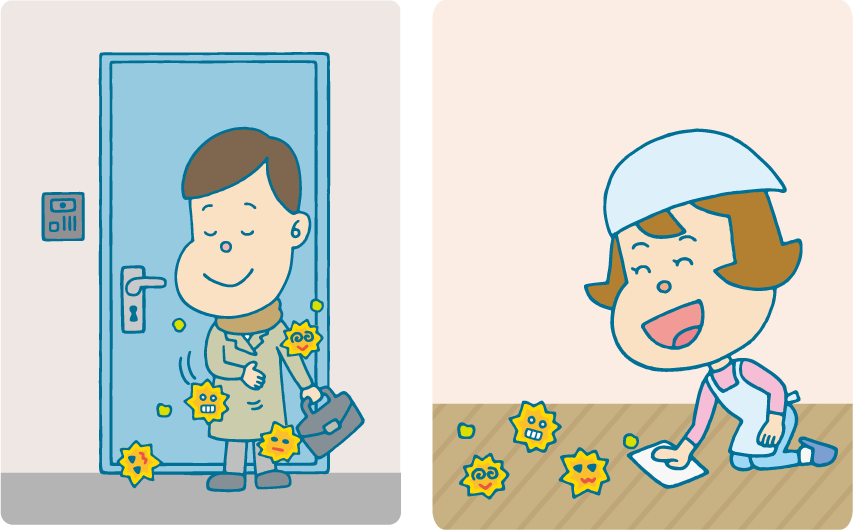
- When you go home, make sure to remove pollen from your clothes and hair before entering the house.
- You should store your clothes that could easily catch pollen near the entrance to avoid scattering pollen in the room.
- When you enter the house, go straight to the washroom and wash your face, hands and gargle.
- It is also recommended to wash off the pollen on your body and hair by taking a shower as soon as possible when you go home. (Please remove it well before going to bed.)
- Let's clean and remove pollen that fall on the floor frequently. (You can also use a vacuum cleaner.)
- If you open a window for about 10 centimeters wide or use a ventilation fan, you can prevent pollen from coming into the room.
How to dry laundry outside
If you dry your laundry outside during the pollen season, it is recommended to do it in the morning when there is less pollen.
On days when it has been raining since morning, the pollen count is low, so it is recommended to open the window and ventilate.
On a fine day
Dry laundry outside until 10 AM, then take it inside and dry it in the room.
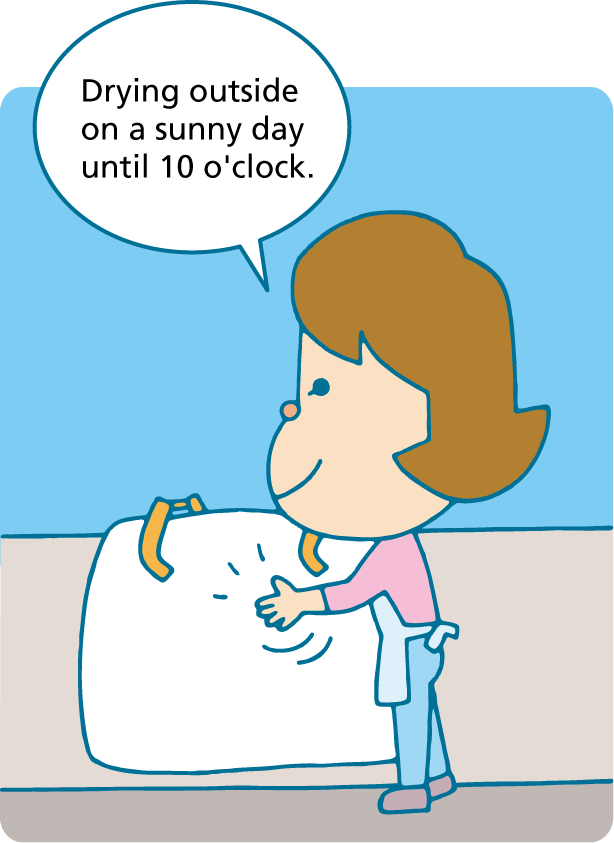
If it rains from morning
Cedar pollen cannot bloom and the amount of pollen decreases, so let's ventilate well on a rainy day.
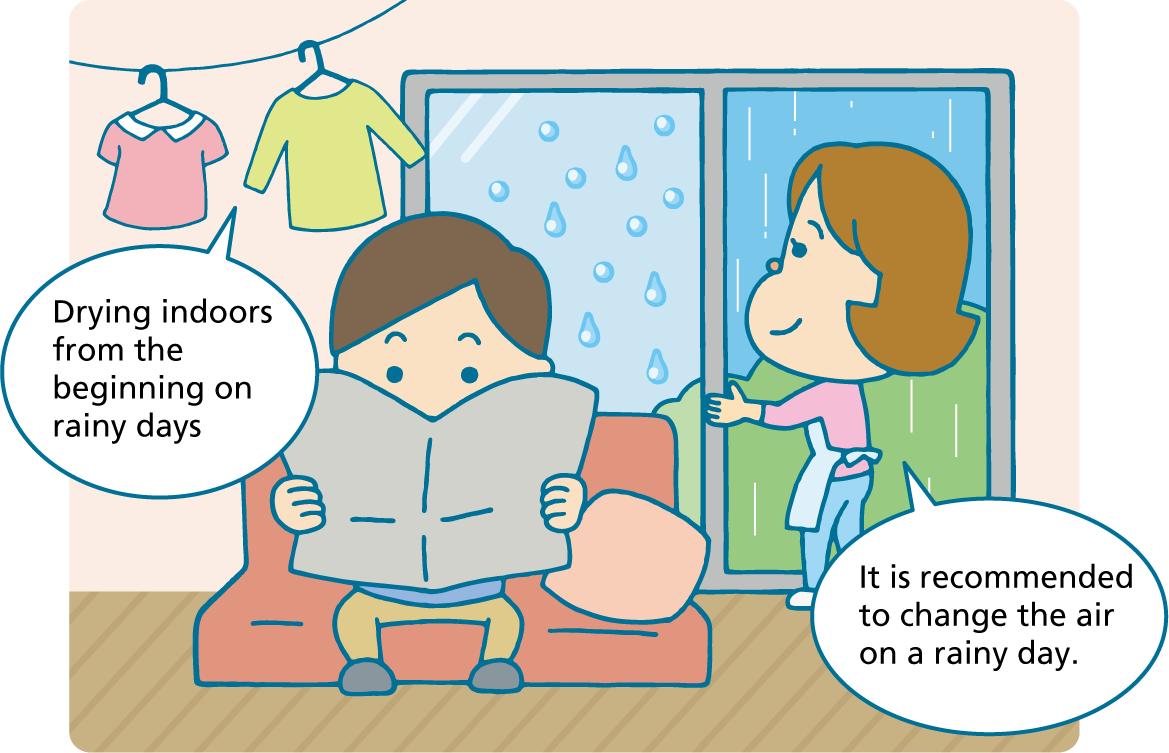
Pollen concentration by time of day - March 15, 2005 Tokyo
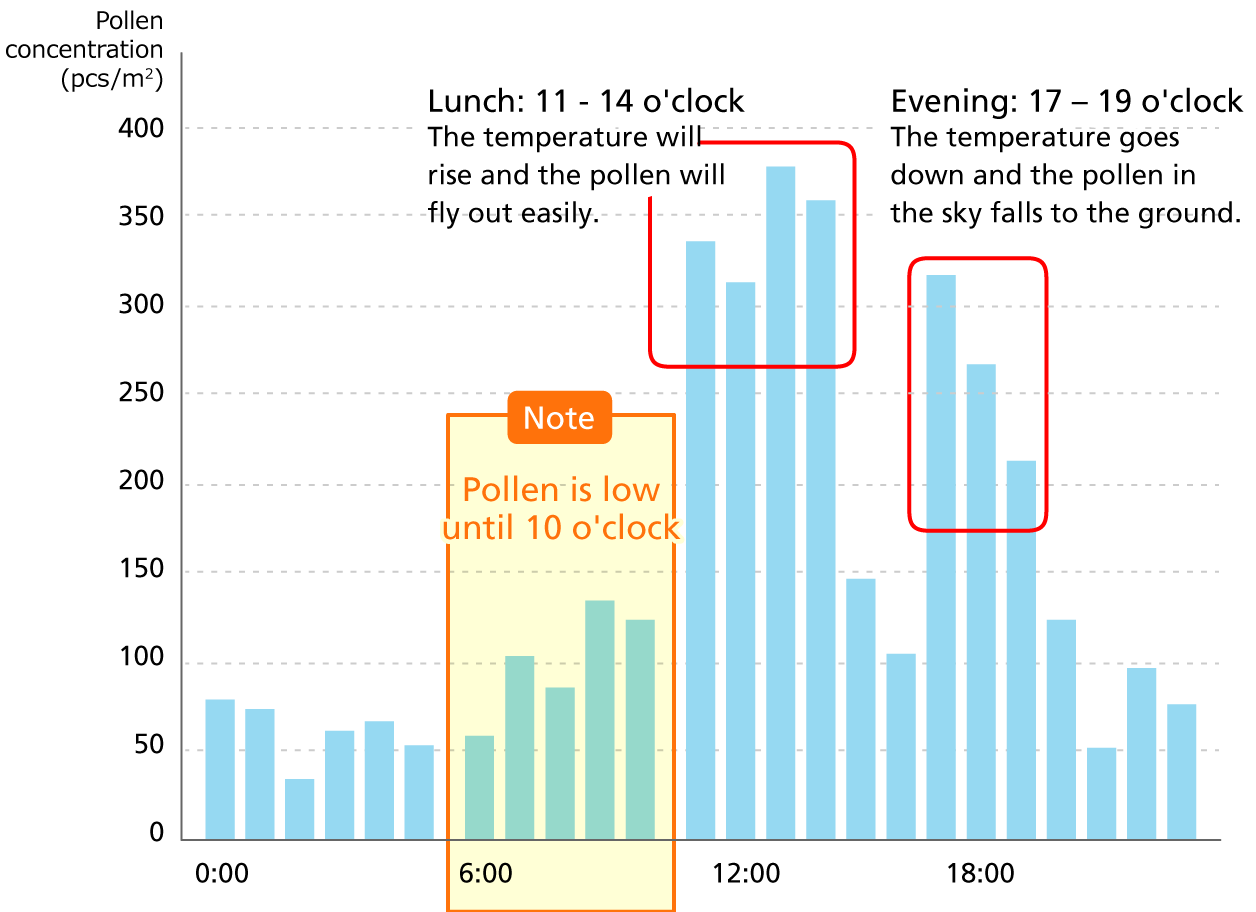
Source: Pollinosis Environmental Conservation Manual 2009 (Ministry of the Environment) Information provided by Kouji Murayama, Meteorological Business Support Center.
What you can do when you go out
| Pollen count in the nose | Pollen count on the conjunctiva | |
|---|---|---|
| No Mask No Glasses |
1848 pcs | 791 pcs |
| Normal Mask Normal glasses |
537 pcs | 460 pcs |
| Pollinosis mask Glasses for Pollinosis |
304 pcs | 280 pcs |
Prevention with masks and glasses
To prevent hay fever symptoms, pollen must not be inhaled or stuck to your eyes. Masks and glasses are effective for pollen protection.
Source: "For accurate treatment of hay fever" Kimihiro OKUBO, Department of Otorhinolaryngology, Nippon Medical School
Clothing recommended for pollen season
Wool clothes tend to carry pollen indoors.
Please avoid wearing it because it has a lot of unevenness and pollen tends to stick to it.
Amount of pollen scattered by time
Number of Japanese cedar pollens adhering to various fibers when left outdoors in the daytime for 4 hours*1
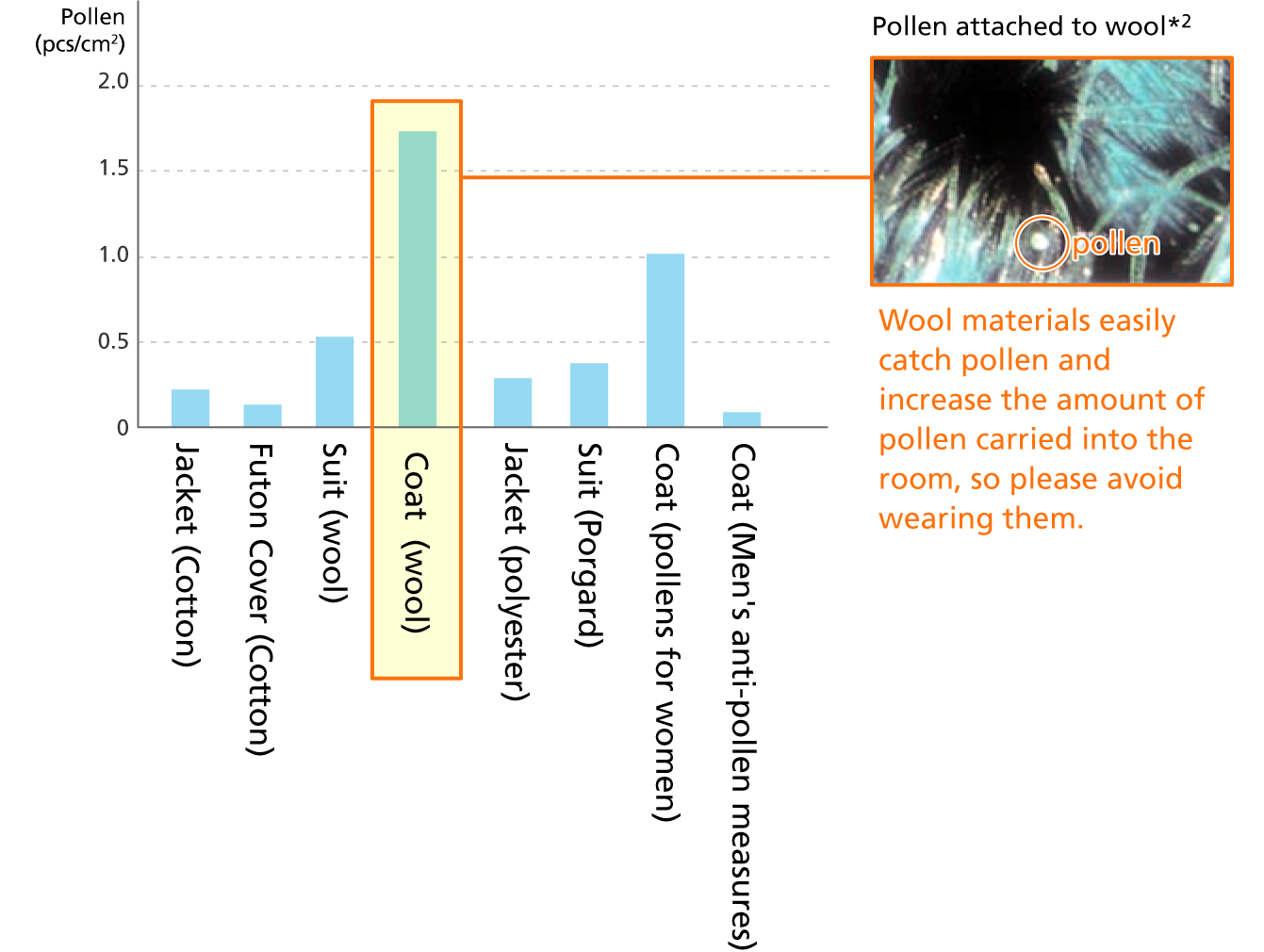
Source: Environmental Conservation Manual for Pollinosis 2009 (Ministry of the Environment)
*1 Research supported by grants from the Japan Health Science Foundation in fiscal 2005
*2 Courtesy of Dr. Minoru Okuda, Professor Emeritus, Nippon Medical School
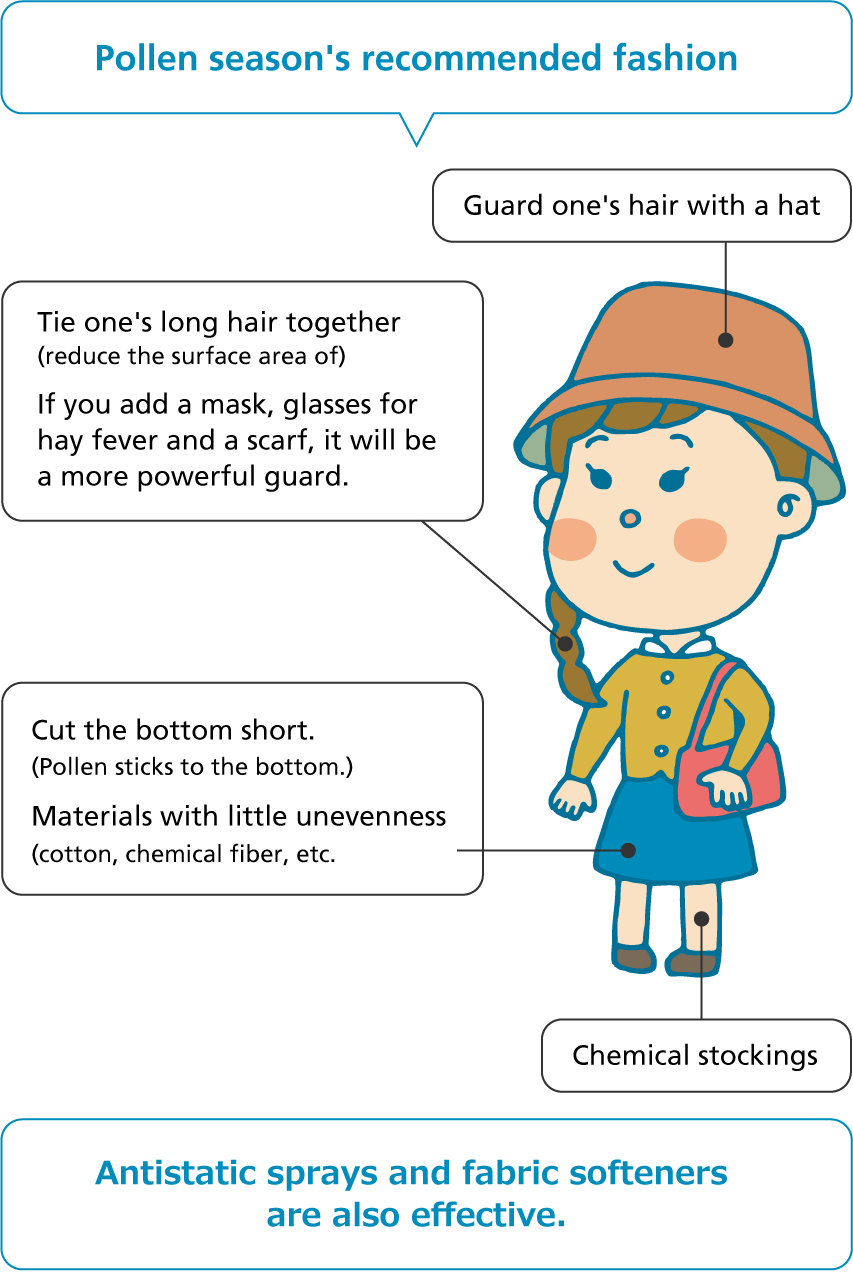
What do you recommend?
Chemical fibers such as cotton and polyester
* Pollen is cannot easily stick and could easily to fall off
Watch your hair.
Pollen tends to stick to your hair, so you should wear a hat to prevent it.
Remove pollen from your room with an air purifier
Effects of air purifiers
During the pollen season, even if you are indoors, pollen can be blown away just by doing daily activities such as dressing, undressing, and putting away futons.
How to select an air purifier
Do not only consider the price but also care for the applicable floor space, the filter life, the durability of the function and choose an air purifier that suits you.
Applicable Floor Area
The larger the "Applicable Floor Area", the faster the room will be cleaned. It is recommended to choose "Applicable Floor Area" which is 2 ~ 4 times the size of the room where the air purifier is installed.
If the applicable floor area is 8 tatami mats, it takes 30 minutes to clean an 8 tatami mat room.
If the applicable floor area is 31 tatami mats, it takes 9 minutes to clean an 8 tatami mat room.
Life of the filter
The life of an air purifier is about 10 years. Therefore, if the life of the filter is less than 10 years, it is necessary to replace it every time, which is costly and troublesome. I recommend the one with long filter life.
Persistence of dust collection capacity
Due to clogging of the filter, the dust collection ability gradually decreases.
It is recommended to choose a large air volume or the one that does not clog the filter easily even after a long use.
Ability to decompose pollen
Cedar pollen contains two types of allelic substances, Criger 1 and Criger 2.
92.4% of people with hay fever respond to both Criger 1 and Criger 2. It is important to decompose pollen to the core.
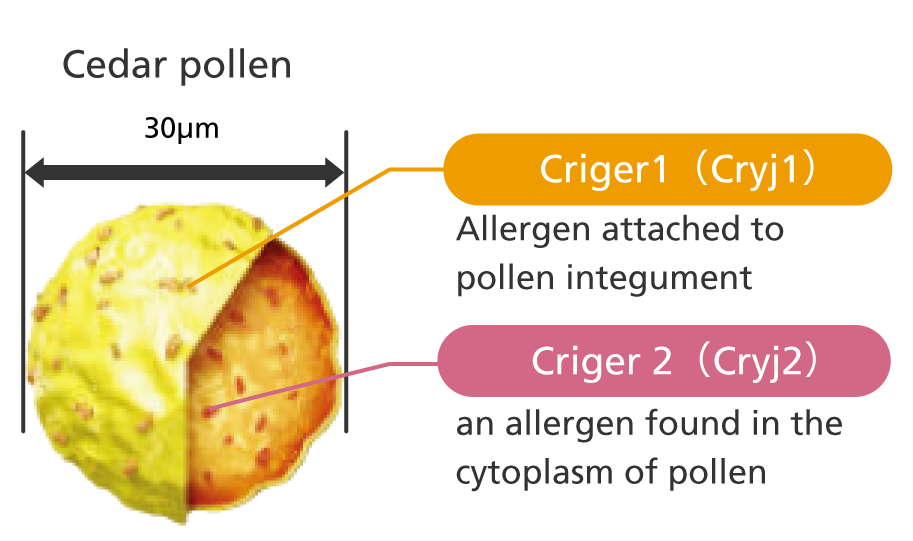
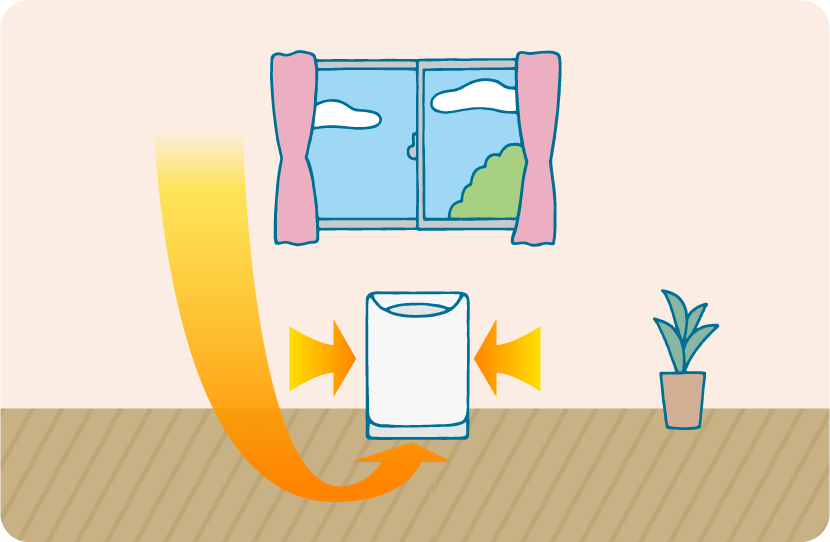
Installation site
Location - close to the door
Since dust and pollen fall to low places, it is effective to place the air purifier near the floor. As a pollen countermeasure, you can get a high effect if you put it near the entrance or the entrance of the room.
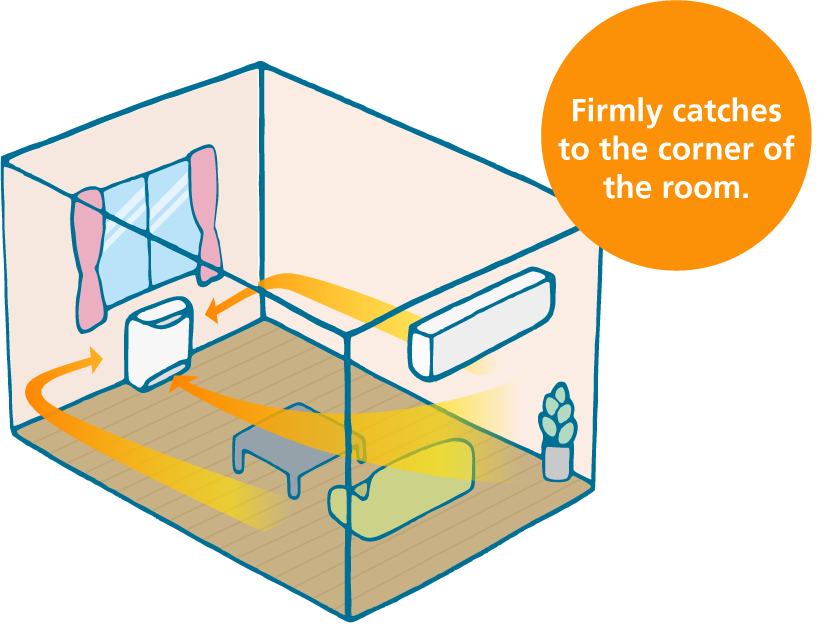
Do not place obstructions near intake or exhaust areas.
The air purifier should suck in and not obstruct the airflow, creating a flow of air in the room and efficiently cleaning the air in the room.
If the air conditioner is in one corner of the room, put the air purifier in the opposite corner.
When placed diagonally across the air conditioner, the synergy with the airflow of the air conditioner improves the airflow in the room and makes the air purifier more efficient.
Operating time
It is ideal to operate an air purifier continuously for 24 hours to prevent pollen. There seem to be many cases where an air purifier is used only in the room when there are people. This means when there are no people, there is no airflow in the room, so dust floating in the room tends to accumulate.
Keep the air in your room clean by operating the air purifier even while you are away.
Even if you use it all day, the electricity charge is less than 10 yen per day*.
*Trial calculation condition: Daikin Humidification Streamer Air Purifier MCK 70 R-W, operating in operation mode "Turbo (Electricity cost per 7.0 m3/min/1 hour: 1.97 yen)" for 10 minutes: 0.33 yen (Assumes time to pick up laundry after returning home), operating in operation mode "Standard (Electricity cost per 3.5 m3/min/1 hour: 0.46 yen)" for 7 hours: 3.22 yen (Assumed in the room), operating in operation mode "High (Electricity cost per 4.8 m3/min/1 hour: 0.78 yen)" for 3 hours: 2.34 yen (Assume you are doing housework), operating in operation mode "Shizuka (Electricity cost per 1.0 m3/min/1 hour: 0.22 yen)" for 14 hours: 3.08 yen (Assumes 7 hours of sleep and 7 hours of absence), total electric bill for 1 day: 8.97 yen (Calculated as 1 kWh = 27 yen)
Good operation method of air purifier according to lifestyle
We recommend you to use different air volume according to your lifestyle and the amount of dust.
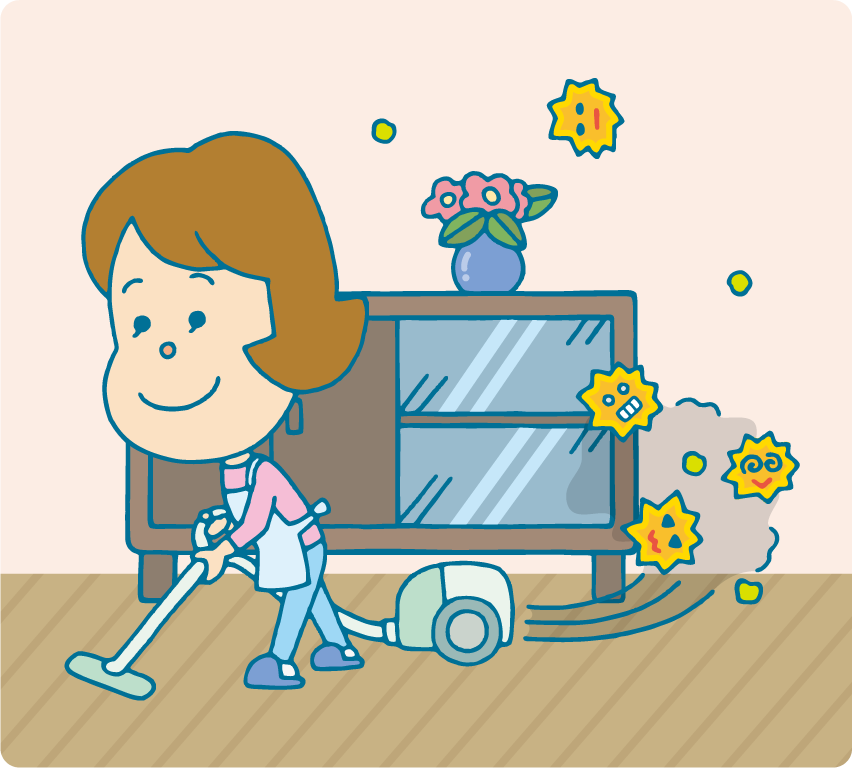
Maximum airflow when cleaning, taking in laundry, or folding
Dust is likely to be generated during cleaning, so catch it quickly with a large air volume. When you take in your laundry, you can quickly remove pollen and exhaust gas from the outside if you operate at the maximum air volume. Also, since pollen and exhaust gas are attached to the laundry that was dried outside, it is recommended to operate with a large air volume when folding it.
Minimum airflow during sleep
We recommend that you drive at the lowest air volume with the least noise so that you can sleep soundly in a quiet environment.
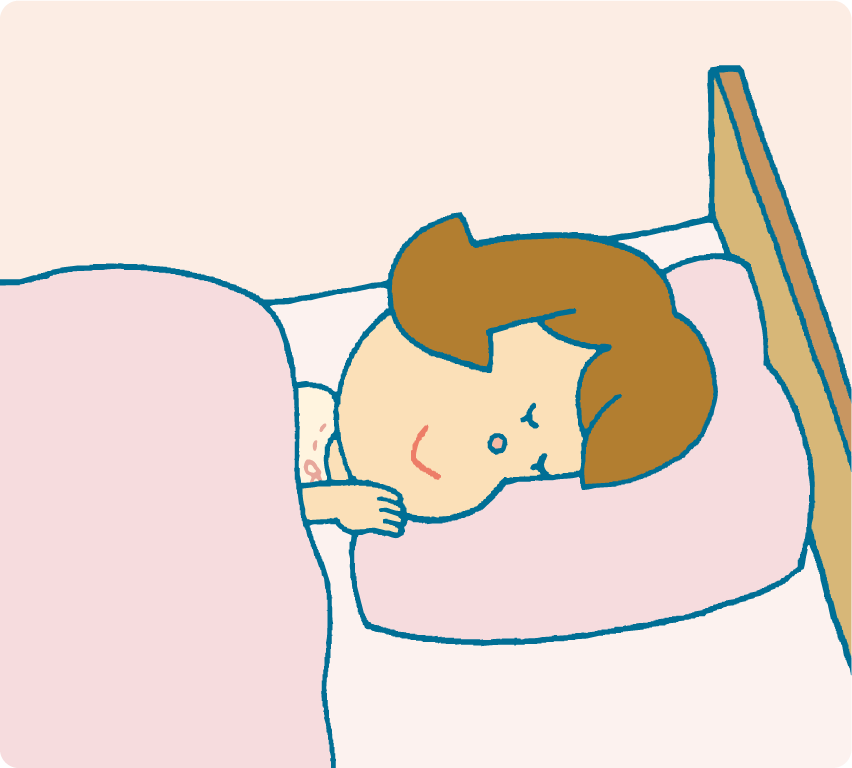
Other Automatic Airflow
Normally, I recommend the automatic operation that has a sensor inside the air purifier to check the amount of dust and automatically adjusts the air volume.
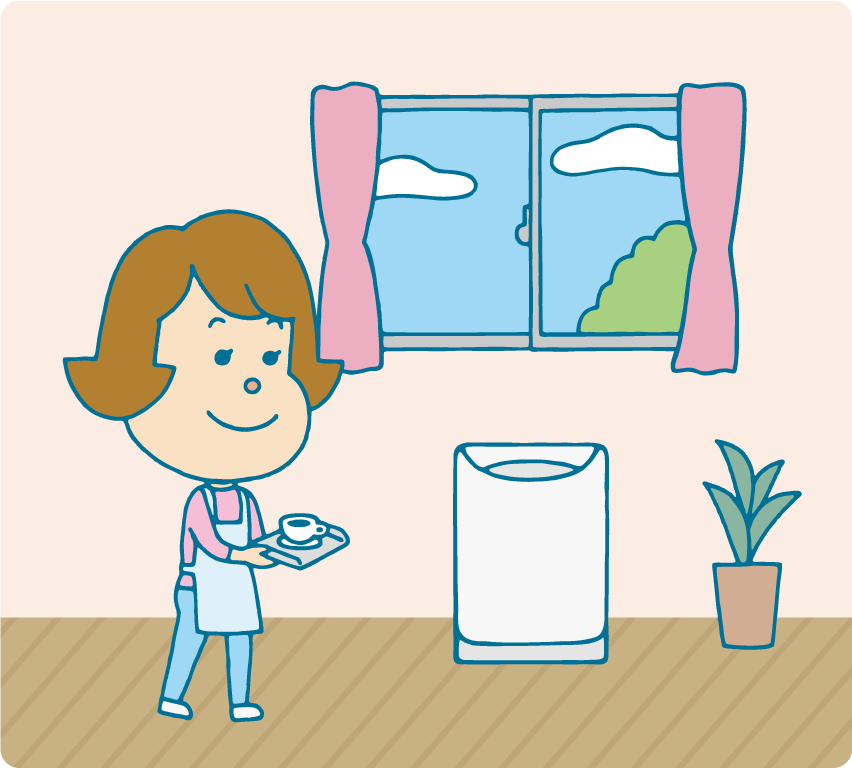
Air Purifier maintenance
To maximize the performance of the air purifier, please take good care of it.
The prefilter that catches big dust should be cleaned once every two weeks.
Generally, air purifiers are equipped with multiple filters. The outermost prefilter, which catches large dust, needs to be vacuumed once every two weeks. If the filter is clogged with dirt, the suction and discharge of air is prevented, and it is not possible to clean the air efficiently.
The necessary care differs depending on the model, so follow the instruction manual of your model for proper care.
Reference information on pollen
Pollen dispersion and the number of patients with hay fever
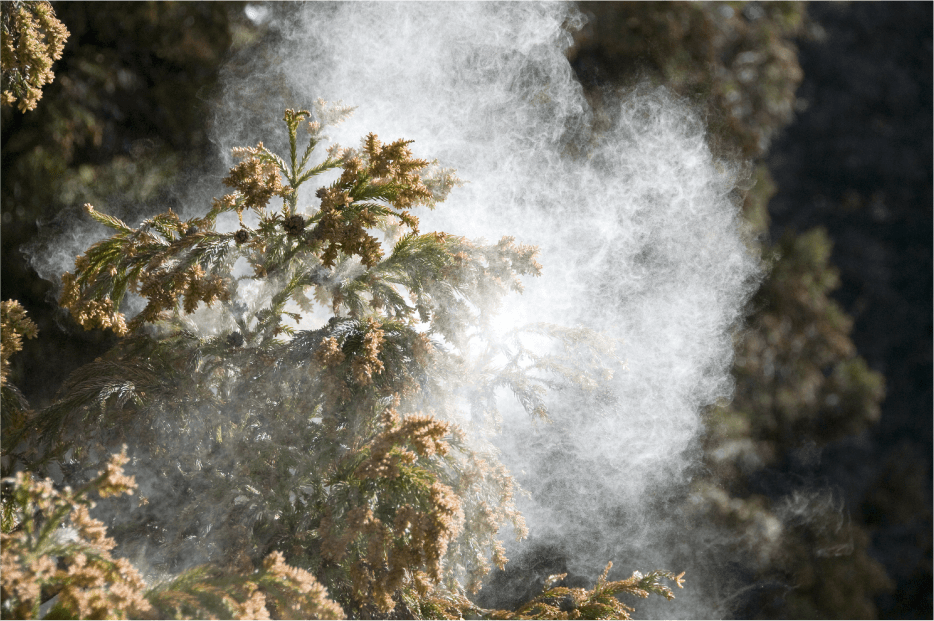
It is said that the reason for the increase in airborne pollen levels is that Japanese cedar trees were planted all over Japan after the war to secure building materials and control water, and in the late 1960s, these trees began to reach the age of 30 years with high pollen productivity. As the amount of pollen scattered has increased, the number of people who inhale pollen has increased and the number of patients with hay fever has increased. Now half of the households in Japan have hay fever.
Number of households with hay fever (In 2008 by Daikin)
Percentage of households with a family member who has hay fever (N = 574 2008 Survey)
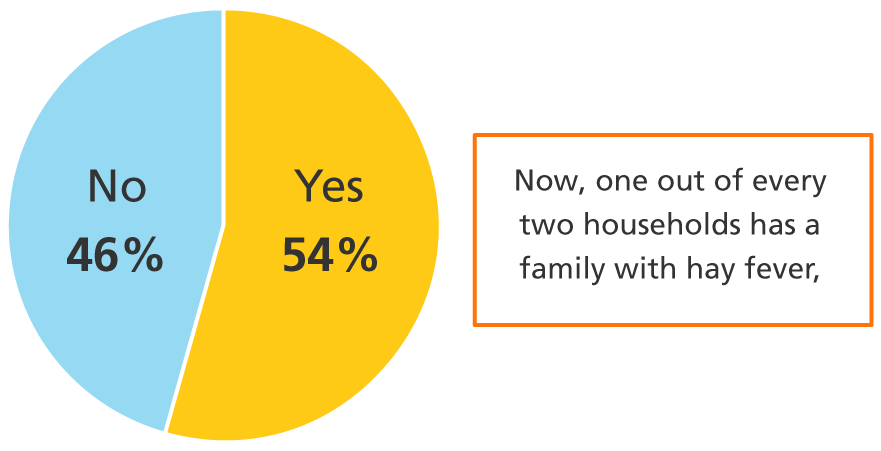
Pollen dispersal
Changes in the amount of pollen scattered
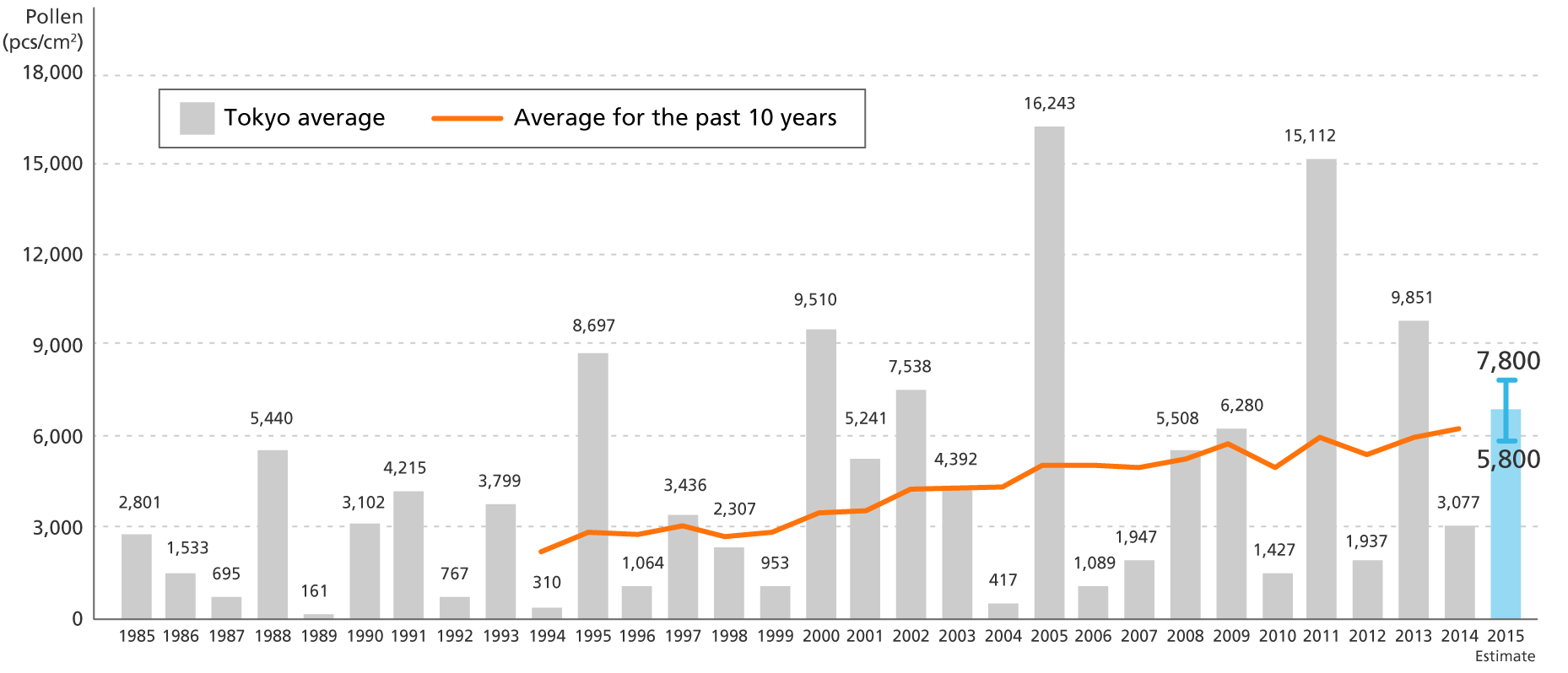
Source: Tokyo Bureau of Welfare and Health
The percentage of people suffering from hay fever in Tokyo (estimate)
| FY 1983 - 1987 | FY 1996 | FY 2006 | |
|---|---|---|---|
| prevalence rate | 10.0% | 19.4% (9.4) | 28.2% (8.8) |
Source: Tokyo Bureau of Welfare and Health
Awareness of pollen
In the season when pollen is scattered, people are especially conscious of "air" in 1 year.
Air-conscious season of the year
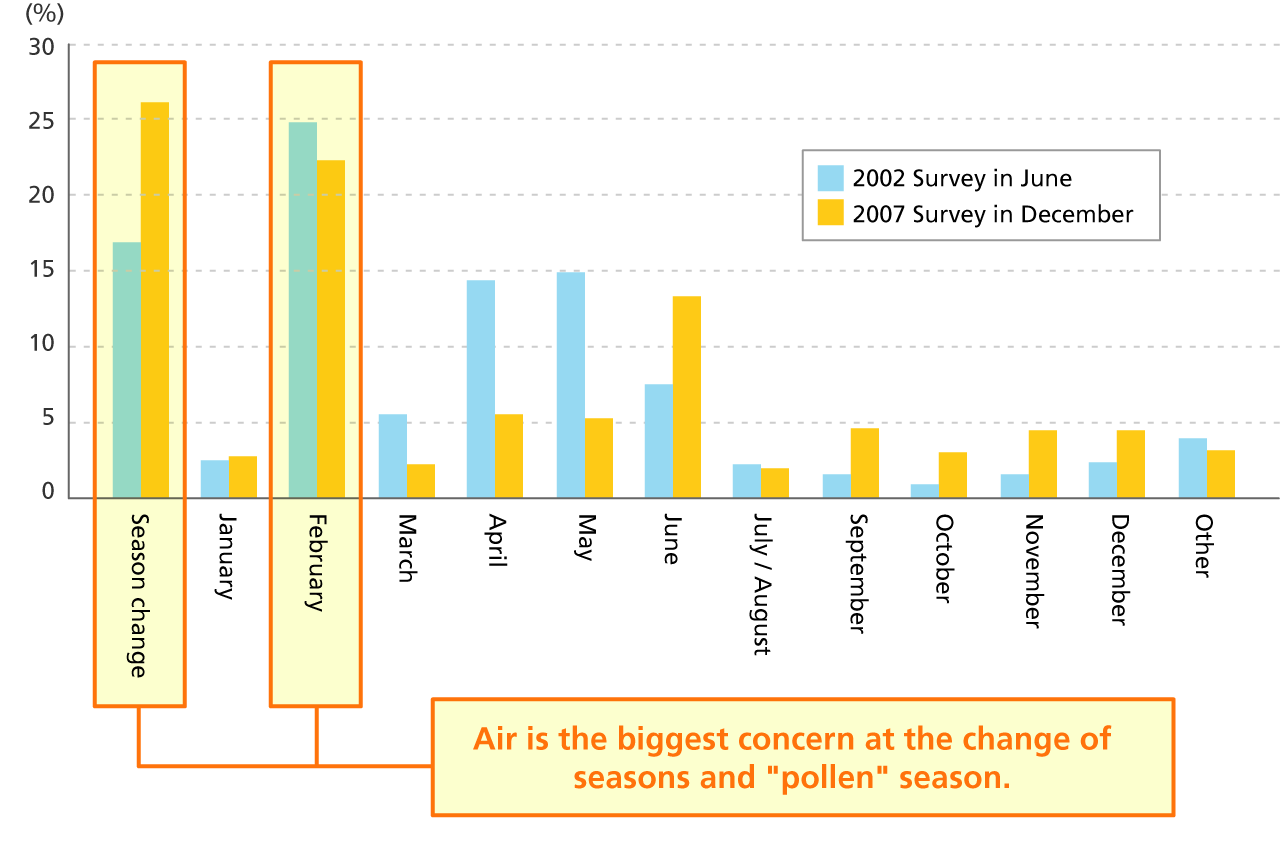
Types of pollen and season of dispersal
Japanese cedar and cypress pollen, which are dispersed in spring, are often talked about, but in fact, pollen is dispersed throughout the year, not just in spring.
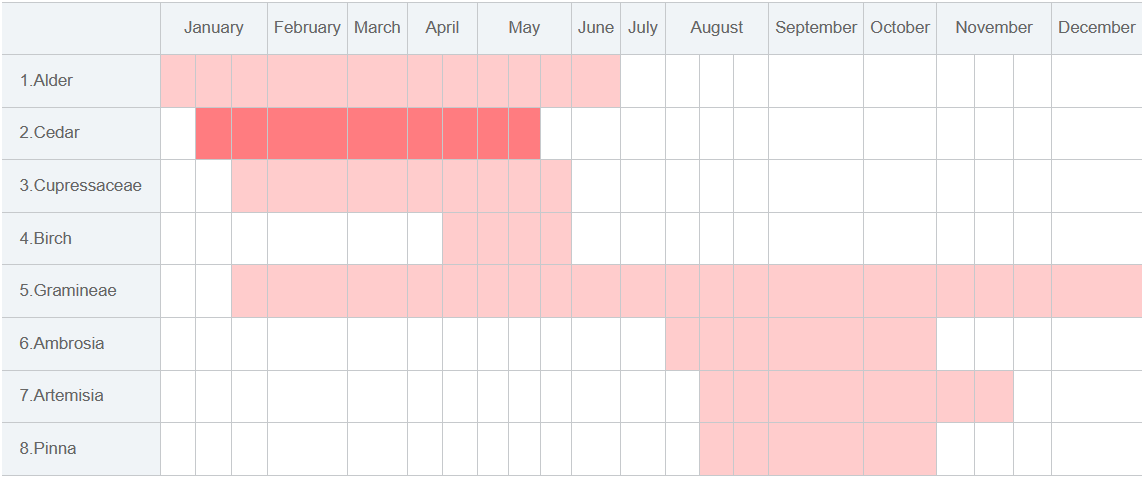
Source: Reorganized based on the nasal allergy diagnosis guideline "Perennial rhinitis and hay fever" 2002 (4th revised edition)
* The total dispersal period was recorded for each region of Japan (Hokkaido, Kanto, Kansai, Kyushu).
* Gramineae ・・・ including giant awagaeri, orchardgrass, and nagahagusa
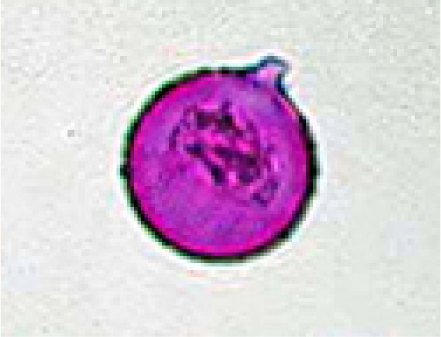
2.Cedar(30µm)
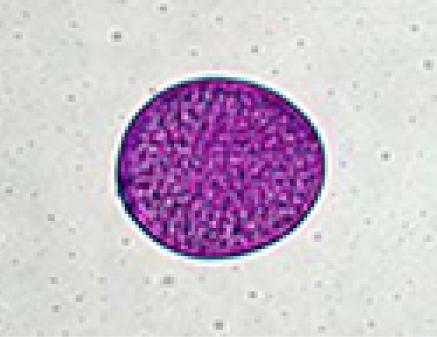
5.Gramineae (20~40µm)
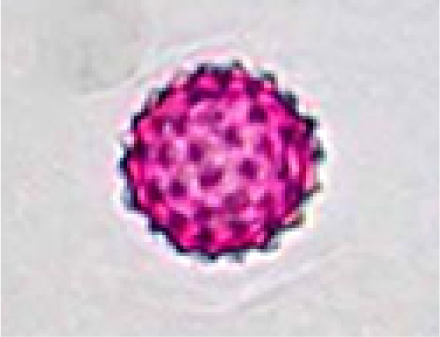
6.Ambrosia(20µm)
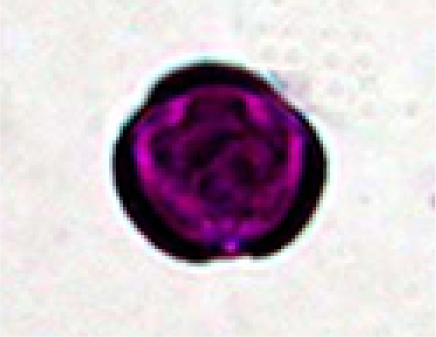
7.Artemisia(25µm)
Source: Sagamihara Hospital website
Environmental factors that determine pollen dispersal
The weather conditions under which pollen is highly dispersed
The amount of dispersed pollen is affected by the weather, so if you understand the weather conditions, you can predict the amount of pollen.
Pollen often flies on such a day.
| Temperature |
Maximum temperature and pollen dispersalDaily pollen count and maximum temperature (2014 in Toyooka)
Source: Hyogo Institute of Health and Human Life Science Research Report |
|---|---|
| Humidity | The air is dry. (It is easy for pollen to fly far when the sky is dry.) |
| Wind |
When the wind is strong, pollen does not fall but scatters in the suburbs and urban areas. Wind Speed and Pollen Count (northerly wind of Tokyo)
Source: Comprehensive Pollinosis Report (Tokyo Metropolitan Government Health Bureau, 1998) |
| Rain | On the day after the rain, two days' worth of male flowers bloom, so the pollen count can be very high. < = > If it rains in the morning, the amount of scattering decreases because cedar male flowers get wet and cannot bloom. |
When the above conditions are met, the amount of pollen scattered increases, so you need to take good measures.
Weather conditions in the previous year when the amount of pollen dispersed increased
It is said that the amount of pollen scattered is greatly related to the weather conditions of the previous year.
- High temperatures continued in the summer of the previous year, and the sunshine hours were long
- The amount of rainfall was small in the summer of the previous year
- The amount of pollen scattered was small in the spring of the previous year.
When the sunshine hours are long and the temperature is high, the flower buds grow well and the amount of pollen dispersed in the next year increases.
Pollen count and solar radiation
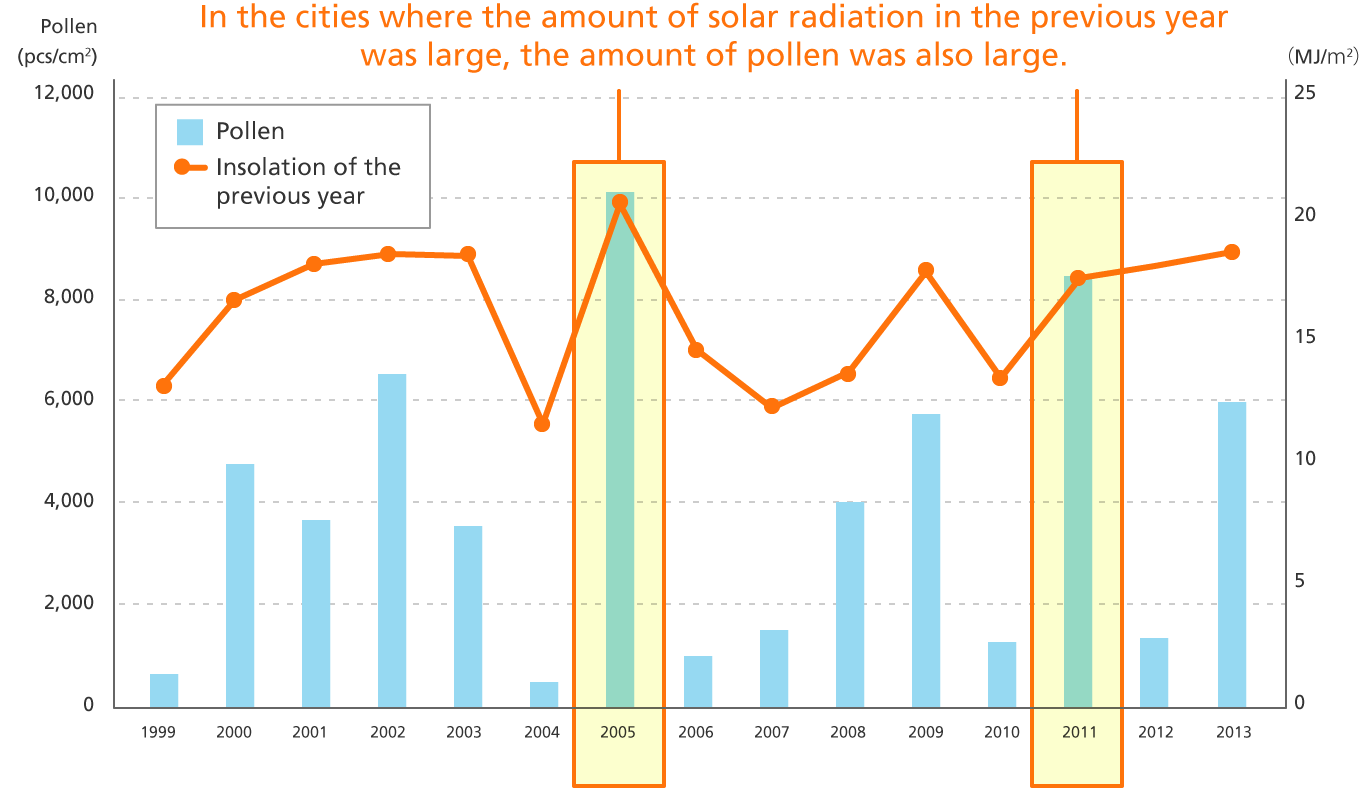
Source: Pollen Disease Environmental Conservation Manual 2014 (Ministry of the Environment)
Difference between rural pollen and urban pollen
Japanese Cedar Forests and the Occurrence of Pollinosis in Japan
Why is the percentage of people suffering from hay fever high in urban areas with few cedar forests?
Relationship between the Percentage of People with Japanese Cedar Pollinosis and the Percentage of Japanese Cedar Plantation Forests
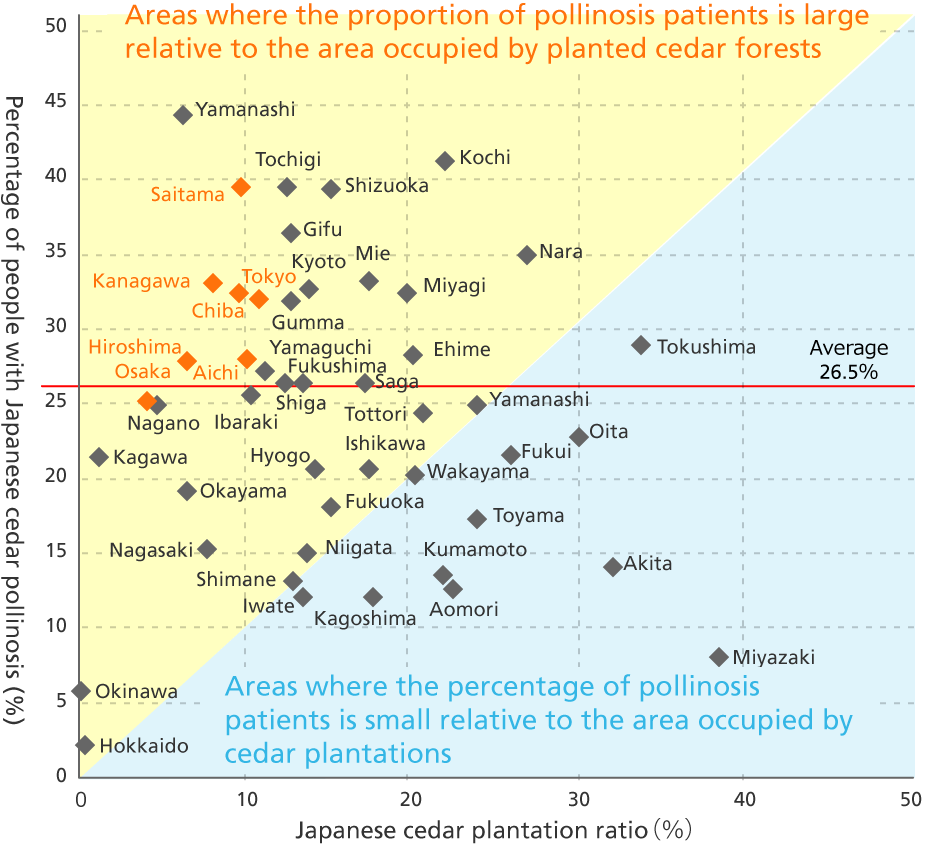
- Percentage of Sugi Plantation Forests Percentage of the area of Sugi Plantation Forests in Japan based on Forestry Agency data (2007)
- Regional blocks are based on MAFF's national agricultural area classification
Source: Prevalence of Japanese cedar pollinosis Katsuji Udagawa 'Numbers tell us about "Ura" and "Omotte" in modern Japan.' Gakken Shinsho (2009) * Prevalence of pollinosis was from a 2008 survey.
In addition, the website of the Ministry of Agriculture, Forestry and Fisheries and the Statistics Bureau of the Ministry of Internal Affairs and Communications "Statistics for Japan 2009"
The percentage of people suffering from hay fever is likely to be high in urban areas due to the peculiar situation that there are a lot of exhaust gas in the atmosphere and the ground surface is covered with asphalt.
Let's look at the difference between urban pollen and rural pollen.
Rural and urban pollen
Unlike rural air, urban air contains a lot of air pollutants called adjuvants.
When pollen moves from the mountains, it absorbs this air pollutant and is carried to the cities.
Rural pollen
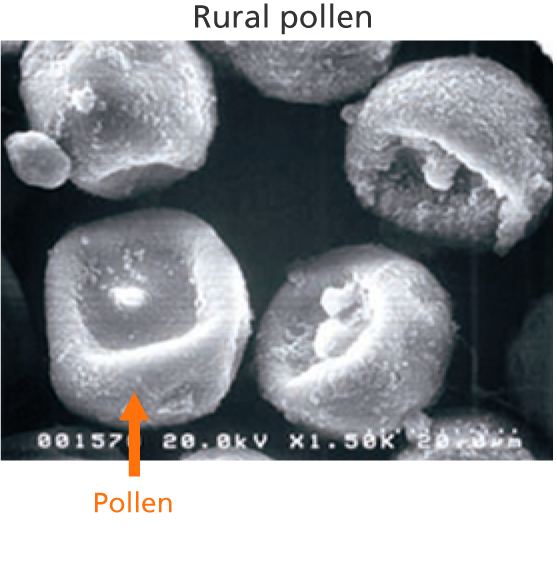
Urban pollen
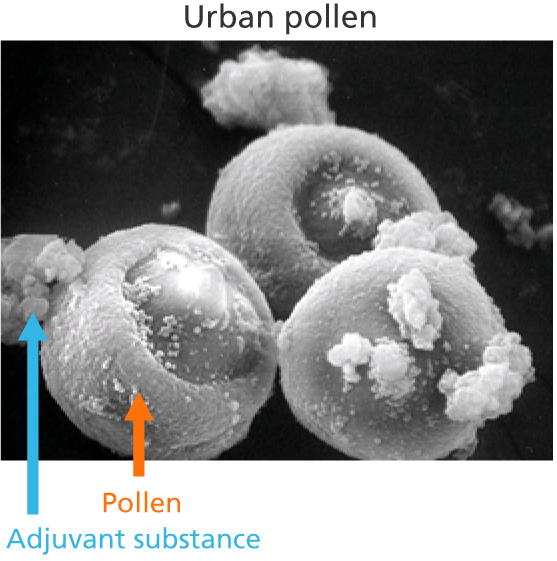
Photo by: Nobuyuki Shirasawa, Associate Professor, Yamagata University School of Medicine
Cause of increased hay fever
There are adjuvant substances in the air that make allergic symptoms worse.
By inhaling pollen and other allelic substances, Substances
that worsen allergic symptoms are called adjuvant substances.
Major adjuvant substances include diesel dust emitted from
automobiles and formaldehyde used in building materials.
Typical example of an adjuvant substance diesel dust
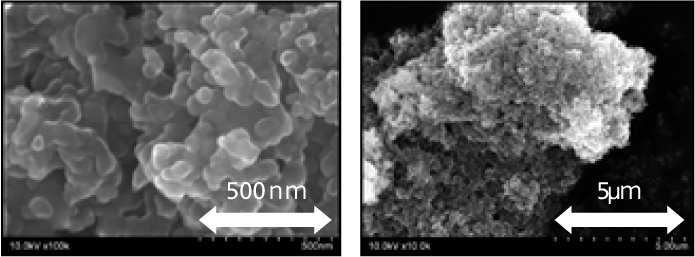
Photo: Associate Professor Nobuyuki Shirasawa, Yamagata University School of Medicine
Cause of increased hay fever
- Air pollution
- Airtightness of houses
- Asphalting of the ground
- High protein diet
- Overprotection in childhood
- Stress society and increased hypothermia
- Increase in cedar pollen
The actual conditions of pollen in urban areas that are worsening due to changes in the external environment;
We will explore the [cause of worsening symptoms].
Mechanism of exacerbation of pollinosis by adjuvant
Relationship between adjuvant substances and symptoms of pollinosis
Diesel dust, an adjuvant substance, is said to double the symptoms of hay fever.
Relationship between symptoms of pollinosis with and without diesel dust
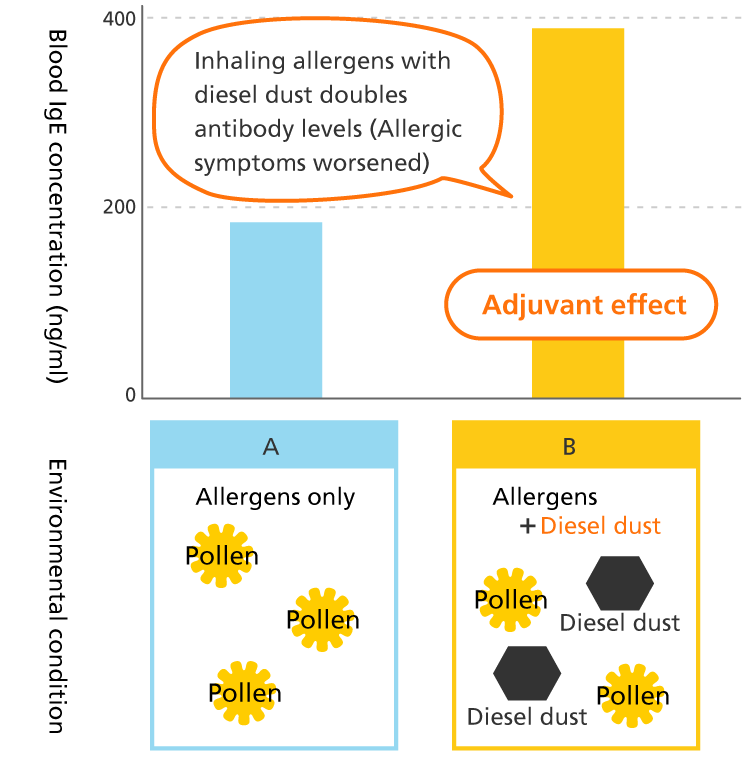
Adjuvant effect
"Adjuvant effect" refers to the effect of diesel dust such as exhaust gas and formaldehyde on allergic symptoms.
Announcement: Test conditions on June 9, 2005: Healthy mice were administered antigen (ovalbumin) intraperitoneally every 2 weeks (injection) and the total IgE level in the blood was measured at 8 weeks. (Joint research with Daikin Industries, Wakayama Medical University and National Institute for Environmental Studies)
Familiar "allelic substance" and "adjuvant substance"
There are many adjuvant substances around us that exacerbate allergies.s
